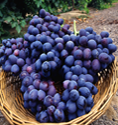What Is Pectin?
Pectin refers to a group of diverse and complex polysaccharides (type of carbohydrate) found in plants. The dominant polysaccharides in pectin are homogalacturonan, rhamnogalacturonan I, rhamnogalacturonan II, and xylogalacturonan. All the pectic polysaccharides are mostly composed of a sugar acid called D-galacturonic acid, derived from galactose. Pectin is a soluble fiber.
Food Sources of Pectin
Pectin is present in all plants, but the content and composition varies depending on the species, variety, maturity of the plant, plant part, tissue, and growing condition. Pectin is higher in legumes and citrus fruits than cereals. Apple, grapefruit, orange and apricot are known to have high levels of pectin. Generally, 60 - 70 percent of the dietary fiber in citrus fruits is pectin. Other sources of pectin include banana, beets, cabbage, carrots.
Table 1: List of sample pectin food sources and measurements of their pectin content.
| Pectin Food Source | Pectin Content (gram/ 100 gram edible weight) |
|---|---|
| Cornflakes | 2.5 |
| Carrot | 0.8 |
| Peach | 0.7 |
| Peas | 0.6 |
| Apple | 0.5 |
| Beans | 0.4 |
| Potato | 0.3 |
Source: Hallowoy et al. (1983).
Pectin concentration reported in the literature varies depending on the method of measurement and the sample used. For example, the same fruit could have different pectin content and composition depending on the variety, maturity of the fruit, and growing condition of the fruit. There fore, it is important to use the data as a guide and not as absolute value. Below is another chart of pectin levels in various fruits. It is extracted from a review paper cited under the table.
| Fruit | Pectin Content (grams/100 grams fresh weight) |
|---|---|
| Apple | 0.5 - 1.6 |
| Banana | 0.7 - 1.2 |
| Carrot | 0.2-0.5 |
| Gauva | 0.77 - 0.99 |
| Lemon pulp | 2.5 - 4.0 |
| Mango | 0.26 - 0.42 |
| Orange peel | 3.5 - 5.5 |
| Papaya | 0.66 - 1.0 |
| Passion fruit | 0.5 |
| Passion fruit rind | 2.1 - 3.0 |
| Peach | 0.1 - 0.9 |
| Pineapple | 0.04 - 0.13 |
| Strawberries | 0.6 - 0.7 |
| Tomato | 0.2 - 0.6 |
(Source: Thakur, et. al., 1997)
Health Benefits of Pectin
Pectin is a soluble dietary fiber and may have health benefits to humans.
Pectin, as a dietary fiber, slows down passage of food through the stomach. It helps prevent a surge in blood glucose levels by promoting satiety, and possibly by reducing the rate of glucose uptake following consumption of glycaemic (available) carbohydrate; therefore it is good for people with diabetes.
Pectin can lower serum cholesterol level, particularly low-density lipoprotein (LDL) Cholesterol. Several studies have reported significant decrease in total blood cholesterol levels, low density lipoprotein (LDL) cholesterol, and increase or no change in high density lipoprotein (HDL) cholesterol in people administered in their diet with pectin supplement or high pectin sources like fruits (eg. apples) and vegetables (eg. carrots). The benefit of pectin in lowering blood cholesterol may be through its role in increasing fecal cholesterol, fecal fat, sterols or bile acids.
A review of several studies reported that consumption of 1 gram pectin lowered total blood cholesterol level by 2.69 mg/dL (0.070 mmol/L) and LDL cholesterol level by 1.96 mg/dL (0.055 mmol/L).
Pectin improves insulin resistance, and relieves diarrhea. It acts as detoxicant, as regulator and protectant of the gastrointestinal tract, as immune system stimulant and as anti-ulcer and antinephrotic agent. It is also suggested to reduce heart disease and gallstones.
Pectin is broken down by bacteria in the colon into short chain fatty acids, known to have health benefits.
Diets containing high pectin food ingredients appear to be better tolerated and greater amounts could be consumed than when pure pectin in powder or capsules were consumed.
Uses of Pectin in Food Preparation
Pectin, due to its physical and chemical property, has high water-holding capacity. Because of this property and texture it imparts, it is isolated from citrus fruits peel and apple pomace and used as a gelling substance in making jams (eg. apple or apricot jams) and thickening foods. Pectin is an important ingredient in industrial yogurt, cakes, ketchup, and fruit jelly.
Pharmaceutical (Medicinal) Uses of Pectin
Pectin is also used in traditional and modern medicine. Traditionally, pectin from panax ginseng is used to treat wound. Also in modern medicine, pectin use in wound bandages is common. Pectin is also an ingriedient in medicinal formulations for heart burn, constipation and diarrhea treatments.
Pectin is completely digested in the colon and releases fatty acids which may indirectly lower risks of colon cancer. Since pectin is fermented only when it reaches the colon, it is one of the strong candidates for coating colon-specific oral drug delivery systems, such as for colon cancer treatment.
Dietary fiber related links:
Total dietary fiber, soluble fiber, insoluble fiber content of foods
Definitions of dietary fiber food.
List of high fiber food: vegetables and fruits
List of low fiber foods
Dietary fiber: Recommended Daily Reference Intakes (DRIs, RDAs) for fiber
References:
Holloway, Warren D, Tasman-Jones, Clifford and Maher, Kerry (1983). Pectin Digestion in Humans. The Ameican Journal of Clinical Nutrition, 37: 253 - 255.
Tin Wui Wong, Gaia Colombo and Fabio Sonvico (2010). Pectin Matrix as Oral Drug Delivery Vehicle for Colon Cancer Treatment. AAPS PharmSciTech. DOI: 10.1208/s12249-010-9564-z.
Lisa Brown, Bernard Rosner, Walter W Willett, Frank M Sacks (1999). Cholesterol-lowering effects of dietary fiber: a meta-analysis. The American Journal of Clinical Nutrition, 69(1):30–42.
Beli R. Thakur , Rakesh K. Singh , Avtar K. Handa & Dr. M. A. Rao (1997)Chemistry and uses of pectin — A review, Critical Reviews in Food Science & Nutrition, 37:1



